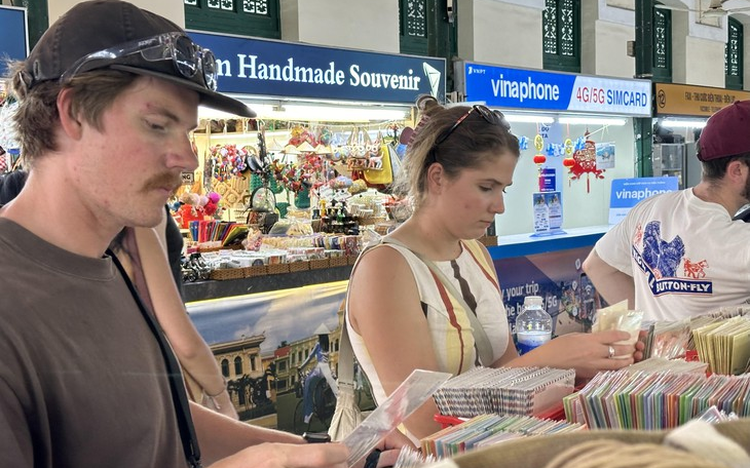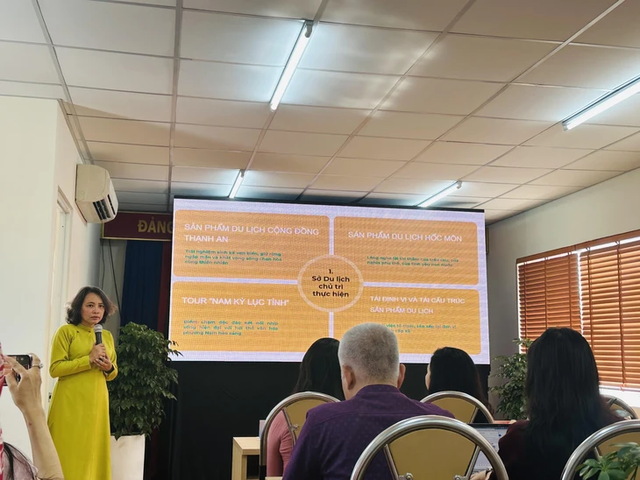
International tourists in Ho Chi Minh City. Photo: Thao Thuong / Tuoi Tre
During a program introducing tourism activities in celebration of the 50th anniversary of the liberation of southern Vietnam and Reunification Day (April 30, 1975–2025), Nguyen Thi Anh Hoa, director of the Ho Chi Minh City Department of Tourism, announced plans to collaborate with cultural experts, researchers, and business communities to develop a scheme to restructure the city’s tourism products in line with the reorganization of commune-level administrative units.
This restructuring will also be connected to repositioning the city's tourism identity, enhancing its competitiveness in the tourism market.
Creating themed tours linked with heritage spaces
Nguyen Thi Thanh Thao, head of the tourism resource planning and development division under the Ho Chi Minh City Department of Tourism, said this is an opportunity to reposition the southern metropolis’ tourism and refresh tourism offerings once new wards are tied to historical significance.
For example, mentioning District 1, District 3, or District 5 does not evoke strong imagery for visitors as Saigon Ward, Cho Lon Ward, or Gia Dinh Ward does. Each of these names carries a unique story, Thao noted.
She added that the city can restructure tourism by creating themed tours and heritage spaces. Every ward can offer its own distinctive experience.
Saigon conjures images of prosperity and vibrancy—perfect for dynamic tours. Gia Dinh evokes the cultural ambiance of southern Vietnam, Thao suggested.
According to Thao, new administrative units can foster a sense of local identity. Residents will become more involved in preserving and innovating the cultural heritage of their neighborhoods, providing a strong foundation for tourism and leaving a lasting impression on visitors.
Forming tourism ecosystem
From the business perspective, a representative from Vietluxtour told Tuoi Tre (Youth) newspaper that preserving or reviving culturally and historically meaningful names adds depth to tourism products, connecting the heritage of old Saigon with modern Ho Chi Minh City.
“This is meaningful for domestic travelers and it can also help international tourists better navigate and understand local tourism information," the representative said.
"It’s a great opportunity to update the tourism map of Ho Chi Minh City."

Nguyen Thi Thanh Thao, head of the tourism resource planning and development division under the Ho Chi Minh City Department of Tourism, analyzes tourism opportunities when the city has new ward names. Photo: Thao Thuong / Tuoi Tre
A unified tourism communication strategy is essential, so that residents and travel agencies can jointly promote the city’s tourism, the Vietluxtour representative claimed.
Dr. Duong Duc Minh, deputy director of the Institute of Tourism and Economy Research Development, emphasized that this is not merely an administrative reform but a pivotal step in shaping a tourism ecosystem for a megacity.
“Ho Chi Minh City’s tourism boundaries are expanding in unprecedented ways," Minh said.
"The city is facing an opportunity of integrating diverse ecological spaces—coastal, heritage, and innovation zones—across Binh Duong Province, Ho Chi Minh City, and Ba Ria–Vung Tau Province.
“This forms the foundation for diversifying tourism products based on distinct ecological characteristics and embedding local community identity into tourism experiences."
He envisions Ho Chi Minh City transforming from a central destination to a multi-centered megacity where visitors can travel quickly, experience deeply, and enjoy personalized journeys.
“In a world increasingly shaped by globalization, travel behavior is shifting toward personalized experiences," Minh said.
"Repositioning the city is part of a broader strategy to redefine its identity and attract visitors by tapping into its cultural depth.
"Bringing back names like Gia Dinh and Saigon through a creative tourism lens helps preserve memories not through nostalgia, but through future-focused deéign."
Under a resolution of the 11th plenum of the 13th Party Central Committee, Ba Ria-Vung Tau Province, Binh Duong Province, and Ho Chi Minh City will merge to form Ho Chi Minh City, with the political-administrative center located in present-day Ho Chi Minh City.
Ho Chi Minh City announced last week a comprehensive plan to streamline its commune-level administrative units, reducing the number of wards and communes to just 102 from 273, as part of its efforts in a major restructuring drive.
After the merger, the city will comprise 78 wards and 24 communes.


Max: 1500 characters
There are no comments yet. Be the first to comment.